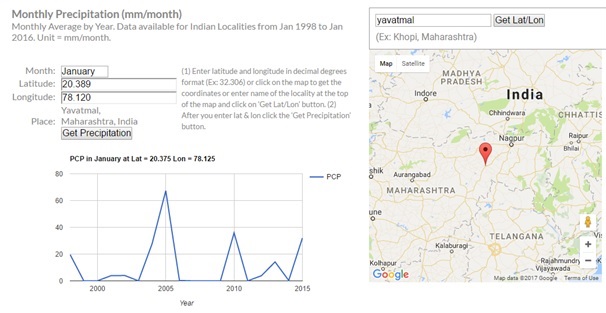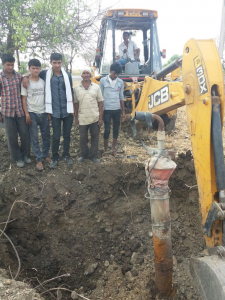Here is how an engineer uses his technical skills to ‘Save Indian Farmers’
Harshitha Ramamurthy
Save Indian Farmers, like many ventures, is a collaboration. This cooperation with other people and organizations is what helps us achieve our mission of saving Indian farmers. One such key partner is Bhoogol – the product of Prashant Pawar’s realization that valuable data is available but does not reach the hands of those who can put it to good use. I had an enlightening conversation with Prashant about Bhoogol – its history, mission and goals, and I’m happy to share what I learned with all of you.
Bhoogol is a Marathi-Hindi word for earth. In the context of this article, it is a website which hosts information like the soil moisture index, vegetation index and rainfall index. Prashant has worked on many development projects related to watershed management with the Tata Institute of Social Sciences in Mumbai, India. He realized through his experience that there is a lot of useful information available out there that will aid farmers and government officials in taking effective steps to combat situations like drought, but this information is neither understood by the layman nor is it reaching him. Thus was born Prashant’s brainchild – Bhoogol, which aims to be a one stop shop for all environmental data of any place in India.
Prashant spoke about how there are a lot of people and NGOs who want to respond to the crisis that farmers face, but they fail to access information that will enable them to help farmers in an efficient manner. He spoke of various outlets that report valuable information. For example, the Indian Meteorological Department has been reporting the rainfall in every district for the past 100 years. It also reports the soil moisture and the vegetation index but the people who need this information are not aware of this. Bhoogol collects raw data from organizations like the National Remote Sensing Centre of ISRO, the Indian Meteorological Department and NASA and presents the data in an easily understandable format.
 Precipitation Data for Yavatmal, Maharashtra from www.bhoogol.org
Precipitation Data for Yavatmal, Maharashtra from www.bhoogol.org
In status quo, the government administration of a district manually collects data like soil moisture and drinking water availability. This is time-consuming and prone to human error. Hence, by the time the government realizes a drought is coming in January or February, it is too late to take steps to combat it for the summer. Instead, if officials access the information readily available from organizations like the Indian MET department, they can know that a drought is imminent as early as October/November. They can then take steps to be prepared and advise the farmers. In addition to the Indian MET department, the National Remote Sensing Centre also reports a month by month analysis of the vegetation index, rainfall index and crops growing across the district. It provides a forecast of the availability of water in each district. All this real time data is already collected and available.
Prashant says that the reason this information is not being utilized as much as it should be is because the data presented by these organizations is not in a readable format. Information available from sources like the MET department, NASA and ISRO’s Bhuvan portal are in a raw format understood only by researchers and professionals in the domain of environmental science. For example, the soil moisture reported by NASA is specific to the latitude and longitude. This isn’t really helpful to a farmer who wants to find out the soil moisture in his field. If this information is presented in a better format, it could be utilized better. Bhoogol does this. To know the soil moisture of a place in Maharashtra, all we have to do on Bhoogol is click on that place on the map to see a graph of the soil moisture index. Try it yourself here. Similarly, we can find out the vegetation index and the precipitation. Prashant uses his own software program and algorithms for this transformation of data.
Prashant works with NGOs like SIF to help them utilize this information to help farmers. He has been involved with Project Jal, our borewell recharge project. This project is aimed at replenishing underground water since the rate of consumption of water from borewells exceeds the rate of replenishment by a great extent. To make this project efficient, SIF makes use of Prashant’s expertise in watershed management. For example, the water table statistics gathered in Bhoogol are used to pick locations for the project. Prashant suggested that it is practical to recharge borewells in fields at least 200 feet apart so that the replenishment in one field is not consumed by the neighbouring field. Prashant also visited sites post the start of the project to suggest improvements specific to the fields. Some fields had streams running nearby and they were redirected to the borewells. At present, the borewell recharge project has recharged 12 borewells in the Beed district of Maharashtra and other places. By the end of year 2017, we hope to have recharged 200 borewells. Prashant continues to be involved in the process by providing valuable feedback and suggestions.

Work in Progress – Project Jal by Save Indian Farmers in Beed district of Maharashtra
Prashant, in addition to working with SIF, also works with noted ecologist and writer, Dr. Madhav Gadgil to help with the India Wiki Files. This is a project to create wiki files for villages and towns for certain states in India. These files provide information about the education, transport sanitation and electricity for all towns in that state. He has also worked with well known social activist, Anna Hazare in the Ralegan Siddhi project. To create awareness among the public about freely available social and environmental information, Prashant writes articles in local newspapers in Maharashtra.
When asked about future plans he has in store for Bhoogol, he said his vision is to make Bhoogol a one-stop portal for anyone wanting to access any environmental information on India. He hopes to extend Bhoogol to provide information on air pollution, water pollution, surface temperature and more. He hopes that this information will aid various NGOs wanting to help farmers, farmers themselves and the general public too.
Prashant is a perfect example of how youngsters equipped with technological skills can use them to innovatively help out others who are not so tech-savvy. It was quite interesting and inspiring to me to learn that he used knowledge he had gained to help farmers, who in most cases do not have access to the same knowledge. This had me thinking – how could I have done the same with the knowledge I had gained and why had I not done it? If only more people put their skills to use to help others in addition to making a living, the world would shine brighter.
I hope this article serves as an inspiration to anyone who wants to make a difference just like Prashant’s work did to me.
